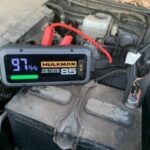Hybrid electric vehicles, often referred to as Car Hybrids, represent a blend of traditional and electric vehicle technology. They uniquely combine an internal combustion engine with one or more electric motors, drawing power from batteries. Unlike fully electric vehicles, car hybrids are not designed for external charging. Instead, they ingeniously replenish their batteries through regenerative braking and the combustion engine itself. This system allows for the potential use of a smaller, more efficient engine, as the electric motor provides supplementary power. Moreover, the battery takes over to power auxiliary functions, minimizing engine idling when the vehicle is stationary. This synergy leads to enhanced fuel economy without compromising on vehicle performance.
Core Components of a Car Hybrid System
To understand how a car hybrid operates, it’s essential to explore its key components:
Auxiliary Battery: This low-voltage battery is crucial for initiating the car’s systems before the main traction battery engages. It also consistently powers vehicle accessories.
DC/DC Converter: This component plays a vital role in managing electrical power by converting the high-voltage DC power from the traction battery to a lower voltage, suitable for powering accessories and recharging the auxiliary battery.
Electric Generator: During braking, the electric generator captures kinetic energy from the rotating wheels and converts it into electricity. This regenerated energy is then directed back to the traction battery, enhancing efficiency. Certain car hybrids utilize motor generators that serve dual purposes of drive and regeneration.
Electric Traction Motor: Powered by the traction battery pack, the electric traction motor is responsible for driving the vehicle’s wheels, providing electric propulsion. As mentioned, some configurations employ motor generators for both driving and energy regeneration.
Exhaust System: A standard component in combustion engine vehicles, the exhaust system safely channels exhaust gases away from the engine through the tailpipe. It includes a three-way catalyst to minimize harmful emissions.
Fuel Filler: This is the access point for refueling the vehicle with gasoline, accommodating a standard fuel dispenser nozzle.
Fuel Tank (Gasoline): The fuel tank stores gasoline, providing the necessary fuel reserve for the internal combustion engine.
Internal Combustion Engine (Spark-Ignited): Typically gasoline-based, this engine uses spark plugs to ignite the air-fuel mixture within the combustion chamber, providing primary or supplementary power.
Power Electronics Controller: This sophisticated unit acts as the brain of the electric drive system, managing the flow of electrical energy from the traction battery. It precisely controls the electric motor’s speed and torque output.
Thermal Management System: Maintaining optimal operating temperatures for the engine, electric motor, power electronics, and other components is crucial. The thermal system ensures all parts function within their designed temperature ranges.
Traction Battery Pack: This high-voltage battery pack is the energy reservoir for the electric traction motor, storing the electricity needed for electric driving and power assist.
Transmission: The transmission system efficiently transfers mechanical power from both the internal combustion engine and/or the electric traction motor to the wheels, enabling variable speed and torque delivery.
